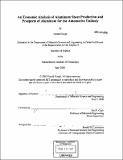An economic analysis of aluminum sheet production and prospects of aluminum for the automotive unibody
Author(s)
Hoegh, Harald, 1976-
DownloadFull printable version (3.837Mb)
Other Contributors
Massachusetts Institute of Technology. Dept. of Materials Science and Engineering.
Advisor
Joel P. Clark.
Terms of use
Metadata
Show full item recordAbstract
In order to lower fuel consumption and reduce emissions, aluminum is being considered as an alternative to steel in large scale production of autobodies. This study evaluates the prospects of aluminum sheets as a cost efficient alternative to steel in autobodies with the unibody design. The study focuses on the processing technologies and alloy selection for aluminum automotive sheets and looks at the impact of these on the total part forming cost of the unibody. Technical cost modeling was used to analyze the costs of traditional direct chill casting and subsequent rolling of aluminum alloy sheet and compared the technology to the alternative continuous casting fabrication method. A change to continuous casting displayed large potential cost savings and was believed to be crucial in order for aluminum to be competitive with steel. A large cost penalty is associated with the alloying and heat treatment of 6xxx series sheet for outer body panels as opposed to 5xxx series sheet for interior panels. Changes in production method for 6xxx series sheet or a replacement by 5xxx series sheet will have large impact on the cost of the autobody. The volatility in the price of aluminum ingot has a critical influence on the price of sheet. Changes in the price level have been shown to be equally critical for the final sheet cost as substantial technical improvements. Recent developments of high strength steel have shown promise for substantial weight reduction in steel automobiles and make the challenge even greater for aluminum as its possible successor.
Description
Thesis (S.B.)--Massachusetts Institute of Technology, Dept. of Materials Science and Engineering, 2000. Includes bibliographical references (p. 48).
Date issued
2000Department
Massachusetts Institute of Technology. Department of Materials Science and EngineeringPublisher
Massachusetts Institute of Technology
Keywords
Materials Science and Engineering.